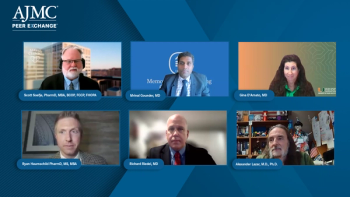
Switching From Aflibercept to Bevacizumab Results in Cost Savings Without Sacrificing Visual Acuity, Says Dr Jennifer Sun
The Protocol AC study analyzed visual acuity gains and cost if patients with diabetic macular edema started on bevacizumab, which costs less, and switched to aflibercept later, explained Jennifer K. Sun, MD, MPH, associate professor of ophthalmology and chief of the Center for Clinical Eye Research and Trials, Harvard Medical School; and chair, DRCR Retina Network.
The Protocol AC study analyzed visual acuity gains and cost if patients with diabetic macular edema started on bevacizumab, which costs less, and switched to aflibercept later, explained Jennifer K. Sun, MD, MPH, associate professor of ophthalmology and chief of the Center for Clinical Eye Research and Trials, Harvard Medical School; and chair, DRCR Retina Network.
Sun presented the findings of Protocol AC at the
Transcript
What is the DRCR Retina Network's Protocol AC? What was it reviewing and what were the outcomes?
Protocol AC, which I presented [at the Angiogenesis meeting] was a study really trying to understand the ability to use a specific form of step therapy for treatment of diabetic macular edema. We have very good data from a previous DRCR Retina Network study—protocol T—that in eyes with diabetic macular edema that start with moderate vision impairment of 20/50 or worse, that aflibercept is, by far, better than bevacizumab for treatment of these eyes. And on average, while both medications improve vision in these patients, the aflibercept-treated eyes gained 18 letters of vision over 2 years compared to the bevacizumab-treated eyes, which gained only 13 letters.
Nonetheless, there are major differences in cost and availability of these drugs. In terms of US dollars, Medicare-allowable reimbursements have been approximately $1800 for aflibercept per dose vs $70 from bevacizumab per dose. Many of the third-party payers these days are requiring step therapy, where the physician and a patient started with a cheaper, more accessible, perhaps, medication and then only move to the more expensive medication if they're not doing as well or if they meet some criteria.
So, we asked—we knew that there's no data on this strategy—is this a strategy that compromises long-term visual acuity relative to just starting with aflibercept—what we would consider the gold standard—right away? We took patients who had central-involved diabetic macular edema and vision of 20/50 or worse and randomized them either just starting therapy with aflibercept, immediately, or using a bevacizumab-first strategy, where we started them on bevacizumab and only switched to aflibercept if the eye was not improving sufficiently over time.
The outcomes of the study basically showed that the visual acuity outcomes were very similar. We didn't identify differences in visual acuity between the aflibercept monotherapy and the bevacizumab groups over 2 years. Now, it is important to recognize that I think about 70% of our patients did end up switching from bevacizumab to aflibercept sometime during those 2 years, and about more than half of those eyes switched early between 12 and 24 weeks.
I think when you're using this strategy, it's important to recognize the fact that the likelihood of switching is high. But from a cost-savings perspective, even just saving those 1, 2, 3 initial injections of aflibercept can make quite a large difference when you're looking across populations. And we actually have a cost-effectiveness
Reference
Hutton DW, Glassman AR, Liu D, Sun JK; the DRCR Retina Network. Cost-effectiveness of aflibercept monotherapy vs bevacizumab first followed by aflibercept if needed for diabetic macular edema. JAMA Ophthalmol. 2023;141(3):268-274. doi:10.1001/jamaophthalmol.2022.6142
Newsletter
Stay ahead of policy, cost, and value—subscribe to AJMC for expert insights at the intersection of clinical care and health economics.







































